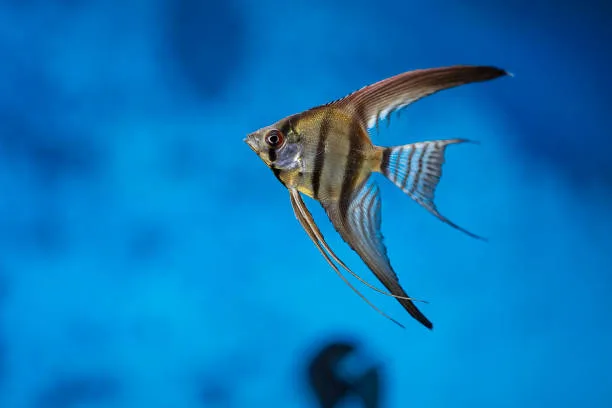Setting up an angelfish tank requires careful planning and attention to detail to ensure the well-being of these beautiful freshwater fish. Here are the steps to set up an angelfish tank:
1. Choose the Right Tank:
- Select a tank that is at least 20 gallons in capacity for a small group of angelfish. Larger tanks are better, as they provide more stable water conditions and swimming space.
- Ensure the tank has a secure lid to prevent angelfish from jumping out, as they are known to do so.
2. Install Filtration:
- Use a high-quality filtration system that can handle the tank’s volume, such as a hang-on-back (HOB) filter or a canister filter.
- Consider adding a sponge filter to provide extra biological filtration, which is important for angelfish.
The Best Filters for Angelfish: A Comprehensive Guide
3. Set Up the Substrate:
- Use fine gravel or sand as the substrate. Angelfish like to sift through the substrate, so avoid sharp or coarse materials.
4. Decorate the Tank:
- Provide plenty of hiding spots and plants for your angelfish to feel secure. They like tall plants and driftwood.
- Use caves or pieces of PVC pipe for additional hiding places.
5. Water Parameters:
- Maintain a stable and appropriate water temperature for angelfish, ideally around 78-82°F (25-28°C).
- Keep the pH level in the range of 6.5 to 7.5 and ensure water hardness is between 3-8 dKH (degrees of carbonate hardness).
6. Cycling the Tank:
- Before adding angelfish, cycle the tank to establish beneficial bacteria that will process waste. This usually takes 2-6 weeks.
- Use an ammonia source (e.g., fish food or pure ammonia) to kick-start the cycling process.
7. Add Angelfish:
- Once your tank is cycled, introduce your angelfish slowly. Start with a small group of 2-4 fish.
- Be sure to acclimate them to the tank water temperature and parameters to minimize stress.
8. Feeding:
- Offer a varied diet to your angelfish, including high-quality flake or pellet food, frozen or live foods like brine shrimp and bloodworms. Fresh vegetables can be added occasionally. Freshwater Angelfish Diet and Feeding
9. Water Maintenance:
- Perform regular water changes (about 20-30% of the tank volume) every 1-2 weeks to maintain water quality.
- Vacuum the substrate during water changes to remove debris.
- Monitor Health: Angelfish Diseases: Common Ailments and Effective Treatments
- Keep an eye on your angelfish for signs of illness or stress, such as changes in behavior, color, or appetite.
- Quarantine new fish before adding them to the main tank to prevent the spread of diseases.
- Maintain Lighting:
- Use moderate lighting to simulate natural conditions and encourage the growth of live plants.
- Maintain Water Quality:
- Regularly test water parameters for ammonia, nitrites, nitrates, pH, and hardness to ensure they remain within the appropriate range.
- Observe Behavior:
- Angelfish are known for their unique social behaviors. Pay attention to their interactions, and make sure they are not being overly aggressive with one another.
By following these steps, you can create a suitable and thriving environment for your angelfish, allowing them to grow and display their graceful beauty in your aquarium.Breeding Angelfish: A Comprehensive Guide
Setting up an angelfish tank can be a rewarding and enjoyable endeavor for aquarium enthusiasts. These elegant freshwater fish are known for their distinctive shape and graceful swimming patterns. To ensure the health and well-being of your angelfish, it’s crucial to create a suitable environment that mimics their natural habitat. In this comprehensive guide, we’ll take you through the steps to set up an angelfish tank. From choosing the right tank to maintaining water quality, we’ll cover everything you need to know.
Choosing the Right Tank
Tank Size Matters
The first step in setting up an angelfish tank is selecting the right tank size. Angelfish can grow to be quite large, and they appreciate spacious accommodations. Here’s what to consider:
Minimum Tank Size
Aim for a tank that is at least 20 gallons in capacity for a small group of angelfish. However, it’s essential to note that larger tanks are generally better. They provide more stable water conditions, reduce aggression among angelfish, and offer more swimming space. A 30-40-gallon tank is a good starting point for a small angelfish community. Choosing an Angelfish: Tips for Selection and Tank Setup
Secure Lid
Angelfish are notorious for being jumpers, so it’s crucial to have a tank with a secure lid. Make sure the lid fits snugly to prevent any escapes.
Installing Filtration
The Importance of Effective Filtration
Proper filtration is essential to maintain water quality and keep your angelfish healthy. Consider the following filtration options:
Filtration Types
- Hang-On-Back (HOB) Filter: These are relatively easy to install and provide good mechanical and biological filtration. Make sure the filter can handle the volume of your tank.
- Canister Filter: Canister filters offer excellent filtration capacity and can handle larger tanks. They are efficient at removing impurities from the water.
Sponge Filter for Biological Filtration
In addition to your primary filter, consider adding a sponge filter. Sponge filters are great for biological filtration, which is important for angelfish. The bacteria living in the sponge help break down harmful ammonia and nitrites.
Setting Up the Substrate
Choosing the Right Substrate
The substrate in your angelfish tank not only serves as an aesthetic element but also plays a role in the overall health of your aquarium. Here’s what you need to know:
Substrate Types
Choose fine gravel or sand as the substrate for your angelfish tank. These materials are gentle on the fish’s delicate fins and barbels. Avoid sharp or coarse substrates that could cause injuries.
Decorating the Tank
Creating a Natural Habitat
Angelfish feel most comfortable in an environment that resembles their natural habitat. This includes plenty of hiding spots and suitable decor:
Ideal Decorations
- Tall Plants: Angelfish appreciate tall plants, such as Amazon swords and Java ferns, that provide cover and mimic the vegetation in their native Amazon basin.
- Driftwood: Adding driftwood not only serves as a shelter but also creates a natural look in the tank. Be sure to choose driftwood that won’t significantly alter water parameters.
Hiding Places
Create caves or provide pieces of PVC pipe to serve as hiding places for your angelfish. These spaces help reduce stress and aggression among fish in the tank.
Water Parameters
Maintaining the Right Water Conditions
Angelfish are sensitive to water parameters, so it’s crucial to maintain stable and appropriate conditions:
Temperature
Maintain a stable water temperature within the range of 78-82°F (25-28°C). Invest in a reliable aquarium heater to regulate the temperature.
pH and Hardness
Keep the pH level in the range of 6.5 to 7.5, as angelfish thrive in slightly acidic to neutral water. Water hardness (GH and KH) should be within the range of 3-8 degrees.
Cycling the Tank
Establishing Beneficial Bacteria
Before adding angelfish to your tank, it’s essential to cycle the tank. This process allows beneficial bacteria to establish, which will help process waste and maintain water quality.
The Cycling Process
- Ammonia Source: To kick-start the cycling process, introduce an ammonia source. You can use fish food or pure ammonia.
- Beneficial Bacteria: Over time, beneficial bacteria will grow and convert ammonia into nitrites and then into nitrates, which are less harmful to your fish.
Adding Angelfish
Acclimating Your Fish
Once your tank is cycled, you can introduce your angelfish. However, it’s crucial to do this slowly and with care to minimize stress:
Acclimation Steps
- Water Temperature: Ensure that the water temperature in the bag matches the tank’s temperature. You can float the bag in the tank to achieve this.
- Drip Acclimation: Gradually add small amounts of tank water to the bag over a period of about 30 minutes.
- Release with Care: Gently release the angelfish into the tank using a net. Avoid pouring the water from the bag into the tank to prevent introducing any bag water.
Feeding Your Angelfish
A Varied Diet for Optimal Health
Providing your angelfish with a balanced and nutritious diet is essential for their well-being. Here’s what you should feed them:
Suitable Foods
- High-Quality Flakes or Pellets: These should make up the bulk of their diet, as they provide essential nutrients.
- Frozen or Live Foods: Offer occasional treats like brine shrimp and bloodworms to add variety and stimulate natural hunting instincts.
- Fresh Vegetables: You can occasionally feed your angelfish small portions of blanched vegetables, such as zucchini or cucumber.
Water Maintenance
Keeping Your Tank Clean
Regular water maintenance is vital to ensure a healthy environment for your angelfish. This includes water changes and substrate cleaning:
Water Changes
Perform water changes of about 20-30% of the tank volume every 1-2 weeks. This helps maintain water quality and removes accumulated waste and nitrates.
Substrate Cleaning
During water changes, use a gravel vacuum to clean the substrate. This will remove uneaten food and waste that has settled on the substrate.
Monitoring Health
Observing Your Angelfish
It’s essential to keep a close eye on your angelfish to ensure they remain healthy and stress-free. Be vigilant for any changes in behavior, coloration, or appetite:
Signs of Health Issues
- Behavioral Changes: Watch for unusual swimming patterns, lethargy, or hiding.
- Color Changes: Fading or abnormal coloration can indicate stress or disease.
- Loss of Appetite: A sudden decrease in food consumption may be a sign of a health issue.
Quarantine New Fish
Before introducing new angelfish to the main tank, quarantine them in a separate tank for a few weeks. This helps prevent the spread of diseases to your established fish.
Maintaining Lighting
Appropriate Lighting Levels
Angelfish benefit from moderate lighting levels that simulate their natural habitat. This promotes the health of live plants and provides a comfortable environment:
Suitable Lighting
Use a lighting
system that offers moderate intensity. LED lights are energy-efficient and can be adjusted to achieve the desired brightness.
Maintaining Water Quality
Regular Water Testing
To ensure the ongoing health of your angelfish, it’s essential to regularly test water parameters and make necessary adjustments:
Water Testing
Use test kits to monitor parameters such as ammonia, nitrites, nitrates, pH, and water hardness. Make sure these values remain within the appropriate range for angelfish.
Observing Behavior
Understanding Social Interactions
Angelfish are known for their unique social behaviors. Pay attention to their interactions and take steps to reduce aggression if necessary:
Aggression Mitigation
If you notice excessive aggression among your angelfish, consider adding more hiding spots and decorations to break up lines of sight. A larger tank can also help reduce territorial disputes.
Conclusion
Setting up an angelfish tank is a fulfilling hobby that allows you to enjoy the elegance and beauty of these remarkable fish. By following the steps outlined in this guide, from choosing the right tank and filtration to maintaining water quality and observing fish behavior, you can create a thriving and harmonious angelfish aquarium. With the right care and attention, your angelfish will flourish and become a stunning centerpiece in your aquatic world. Angelfish Care Guide | Tips for Breeding, Best Tank Setup, tankmates and more https://youtu.be/QLomZRGCcLk?si=YR14W1FVlEtxyJUH











